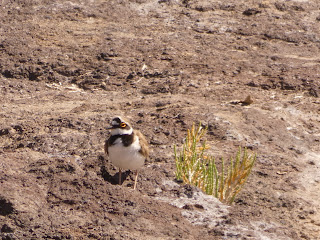Brown Hare
Oystercatchers
Two good shifts put in over the weekend at the pits. On Saturday I was feeling rather ginger from a late boozy night in Birmingham but some how still managed to be there for 7.30am. Highlight was a Black-tailed Godwit which went straight over heading east whilst a Red Kite was hunting on both sides of the pits. On Sunday, I teamed up with Jon aiming to give everywhere a thorough check. A Dunlin was on the main pit early along with 3 Green Sandpiper.
The central lagoon hosted the regular Tufted Duck flock & 3 Little Grebe which was unusual here. We had to reach the south of the pits until we finally recorded a singing Chiffchaff. A good size flash has emerged on the meadow field which contained 6 Snipe.
Sadly our faith was not restored as we ideally wanted to find a Wheatear. There was a steady flow of Meadow Pipit passage all morning, we counted 110 but there would have been many more.
Back at the main pit our pair of Lesser Black-backed Gulls were staking their terriorty again and two female Goosander dropped in. As we edged along the pit I picked up two Sand Martin, becoming our 90th species of the year, but they quickly moved on heading north. Other species of note recorded included a Greater Spotted Woodpecker & Siskin (Plantation), 39 Lapwing, 4 Pochard, 17 Little Grebe, 73 Tufted Duck, 8 Gadwall, 11 Cormorant, 3 Mute Swans, Raven, 10 Buzzards & two Grey Heron. After checking Pophills for the second time a Brimstone butterfly flew past us to round off a good morning.
Chris Lane recorded a Little Ringed Plover midweek but there was no sign on both visits at the weekend indicating a passage bird.
The web count from the previous Sunday conducted by Jon resulted in 10 Little Grebe, 2 Cormorant, 2 Grey Heron, 108 Greylag, 41 Canada Geese, 5 Shelduck, 12 Wigeon, 27 Gadwall, 94 Teal, 120 Mallard, 49 Shoveler, 12 Pochard, 69 Tufted Duck, Sparrowhawk, adult male Peregrine, 430 Red-legged Partridge, 86 Coot, 2 Oystercatcher, 64 Golden Plover, 40 Lapwing, 2 Snipe, 2 Green Sandpipers, 400 Black-headed Gulls, 8 Lesser Black-backed Gulls, 30 Skylark, 80 Fieldfare (NE), 74 Redwing (NE) and Raven.
In addition that were new for year on the site:- female Ruff, Great Crested Grebe, Common Gull and 2 Chiffchaff.



































































